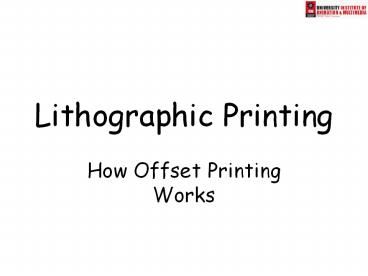Lithographic Printing - PowerPoint PPT Presentation
1 / 34
Title: Lithographic Printing
1
Lithographic Printing
- How Offset Printing Works
2
A Brief History of Printing
- The early " revolution" of moveable printing
failed to ignite the world. - The process of producing printed versions of
Chinese texts was more time consuming than
traditional hand-inscribing. - Storing the thousands of characters in the
Chinese alphabet was a problem. - Pen and oil-based ink was more efficient.
3
Johannes Gutenberg 1436
- Johannes Gutenberg,1436 was a profit-minded
goldsmith from Southern Germany. - His motivation was personal profit he hoped to
get rich by mass-producing the Church's
ever-popular "indulgences".
4
The Printing Press
- The amount of information in one Sunday New York
Times is greater than the amount of information
an 18th century person in England would be
exposed to in his lifetime.
5
The Passage of Time
- As the New World ( America ) grew in importance
so did the media of printed communication. - Gutenberg's technology did not change for 400
years. - The next revolution was the invention of
continuous rolls of paper. - Print availability to the public jumped
astronomically.
6
The Creative Process
Every print piece starts with the creative
process. Writers, editors, graphic designers and
artists are the initial step in the creation of
magazines, newspapers, brochures, flyers,
catalogues and other print pieces.
When each article is written, edited and approved
with final art, the pieces are sent
electronically to the director of graphic design
for page layout.
7
From a simple sketch
To a final colour drawing
8
When each article is written, edited and approved
with final art, the pieces are sent
electronically to the director of graphic design
for page layout. The director determines what
page a story will appear on, where art will be in
relation to words and, in some publications,
where advertising will appear.
9
Lithography
- Lithography is a chemical process .
- Lithography depends on the principle that oil and
water do not mix
10
Images (words and art) are put on plates which
are dampened first by water, then ink. The ink
sticks to the image area, the water to the
non-image area. Then the image is transferred to
a rubber blanket, and from the rubber blanket to
paper.
11
Pre-Press Production
Before the job can be printed, the document must
be converted to film and "plates." Images from
the negatives are transferred to printing plates
in much the same way as photographs are
developed. A measured amount of light is allowed
to pass through the film negatives to expose the
printing plate. When the plates are exposed to
light, a chemical reaction occurs that allows an
ink-receptive coating to be activated.
12
Formatting the page by cutting negatives and
placing them in place before the plate is made.
13
A blueprint of the negative and plate layout,
used to check image positions before printing.
14
There are different materials for plates,
including paper (which produces a lower-quality
product). The best plate material is aluminium,
which is more costly. Each of the primary
colours -- black, cyan (blue), magenta (red), and
yellow -- has a separate plate. Even though you
see many, many colours in the finished product,
only these four colours are used
15
(No Transcript)
16
The Press Run
The printing process used to print our newspapers
is called web offset lithography. The paper is
fed through the press as one continuous stream
pulled from rolls of paper. Each roll can weigh
as much as 2,000 pounds (1 ton). The paper is cut
to size after printing. Offset lithography can
also be done with pre-cut paper in sheet fed
presses.
17
Web presses print at very high speeds and use
very large sheets of paper. Press speeds can
reach up to 50,000 impressions per hour. An
impression is equal to one full press sheet (38
inches x 22 and three quarters), which is 8 pages
of the Express Star.
18
19
20
The press has to maintain a constant balance
between the force required to move the paper
forward and the amount of backpressure
(resistance) that allows the paper to remain
tight and flat while travelling through the
equipment..
21
The Inking Process Ink and water do not mix --
this is the underlying principle of offset
lithography. The ink is distributed to the plates
through a series of rollers. On the press, the
plates are dampened, first by water rollers, then
ink rollers. The rollers distribute the ink from
the ink fountain onto the plates.
22
The image area of the plate picks up ink from the
ink rollers. The water rollers keep the ink off
of the non-image areas of the plate. Each plate
then transfers its image to a rubber blanket that
in turn transfers the image to the paper. The
plate itself does not actually touch the paper --
thus the term "offset" lithography. All of this
occurs at an extremely high speed.
23
(No Transcript)
24
(No Transcript)
25
(No Transcript)
26
Colour control is a process that involves the way
in which the ink blends together, and is tied
closely to the plate registration. The amount of
ink that is released into the units depends on
how much ink is needed to achieve a desired look.
The ink is adjusted via the control panel that is
part of the overall control console.
27
(No Transcript)
28
(No Transcript)
29
Bindery
The bindery is where the printed product is
completed. The huge rolls of now-printed paper
are cut and put together so that the pages fall
in the correct order. Pages are also bound
together, by staples or glue, in this step of the
process.
30
The "stitcher" gathers, assembles and staples the
magazines (called books) before they are sent for
final trimming.
31
(No Transcript)
32
(No Transcript)
33
(No Transcript)
34
(No Transcript)














![Market Report on Worldwide Printing Industry [2015] PowerPoint PPT Presentation](https://s3.amazonaws.com/images.powershow.com/8251546.th0.jpg?_=201510240410)
















